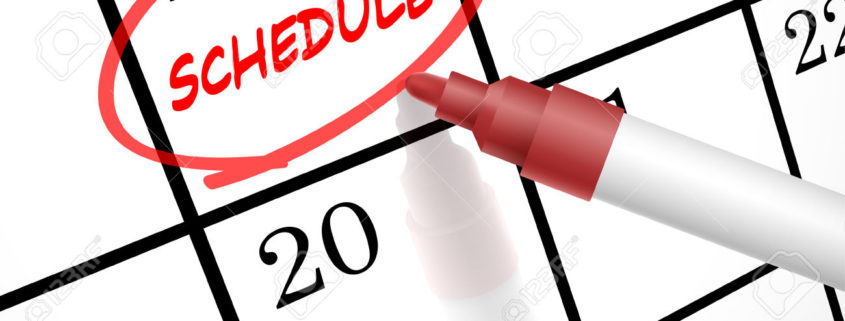The Elusive Schedule
When I first started our home education journey, I felt completely overwhelmed. My children were good at entertaining themselves (the beauty of the pre-device era)… but they got so good at this that structured learning time erupted into epic meltdowns. Sometimes it was one child, sometimes another, sometimes me… and some very special days, all of us! I felt the pressure time slipping away. I knew we were getting further behind in our curriculum. Then, the fear kicked in. Was I ruining my children?
So, I tried several things that different friends suggested, including a beautiful, color-coded, mega-schedule from Managers of Their Homes! It was a WORK OF ART! I was so pleased! Who cares that it took me an entire week to create it – I had arrived! And then I tried to implement it… Brick Wall! Exhaustion! Overwhelm!
We all have faced this in one form or another. It takes time to find our own path to a method that will actually help us. We are trying to balance an impossibly long list of home education goals: academic skills, strong knowledge base, character development, work ethic, thinking skills, attitude, 21st-century skills, etc., How do you fit it all in? In addition, there are other details such as growing closer as a family, feeding, and clothing the crew, and actually teaching them! Finally, we hope to do all of this while not tipping us to THAT side of CRAZY.
I have HAPPY news for you! There are LOTS of options and one of these schedules will fit your own family needs… or you will morph a few together and it will start to flow more smoothly.
There are a few thoughts that I suggest you keep in mind:
- The type of schedule MUST fit the DE parent’s personality and energy cycles, not just the student’s.
- No schedule will work every day and for every season – because life happens! Be prepared to be flexible.
- The journey of discovery is worth it! Don’t worry if you don’t have the perfect fit today… you can ease into it, learn from trying things, and it WILL improve with time.
Where to Start
Whether you use a basic spiral-bound notebook, a printout from the internet, a lesson plan book you can get at any office supply store, a digital drag-and-drop option, or an app for your tablet, start by getting organized.
First, brainstorm. Make a list of activities, subjects, goals for each child in no particular order of importance – this is to capture a broad picture of what you are hoping to accomplish for this child. Write anything you think about. Then, start to organize it all. Sort through it. Jot notes like what it is this child most needs right now in their life, how often to do each subject, and what you can do to simplify the list (suggestions below). Some things are a better fit for daily practice: reading instruction, mathematics to promote the practice of skills and recall; also, consider handwriting practice and foreign languages.
Now start thinking about the flow of energy throughout the day. For example, we found in our home that math daily right after breakfast made certain it didn’t get bumped from the schedule… and quiet reading time every afternoon was my sanity time. Even my littles learned to sit with a big pile of books and “read.” Science and history we looped and blocked (see below) and we ended with family read aloud before bedtime. Hook it into what the rest of the family has going on (regular appointments or lesson schedules) and you have a master schedule. The schedule you create will need to be modified after you try it out and as seasons change, but start somewhere. 😉
One last thing – you notice I did not put times… but general time guideline around our family routines (after lunch, before bed, etc.) to give me a bit of flexibility if the day implodes. AND, so you don’t spend so much time planning that you don’t have time to teach lessons, HERE are some really great tips and advice from a veteran mom on keeping it simple.
Looping
This is a simple way to cover all the extras subjects or resources you may want to fit in with your student’s academic skills schedule. You can loop all of your subjects or just the extras, leaving out the dailies. Then, start at the top and go as far down the list as you have time. The next day, start where you left off. Looping is great for adding a little variety in our life, including some fun after daily skill practice. It also could be great for rotating through some of those awesome resources you check out from the CGA Resource Library. Every day, after we finished our “have to do” list, we would spend about an hour on our loop subjects together before my children all started on their independent pursuits. Fridays we often skipped the skill practice altogether so we had extra time for loop subjects together. 🙂 Some topics we put in this category were art study, art projects, coding, music, root words, new skills (leatherworking, origami, etc.), math games, and poetry. So fun! Here are some more ideas about looping.
Block Schedule
A block schedule uses blocks of time to focus on a specific subject. If your list of subjects is too long, it is hard to give it all the focus it deserves. Maybe you do science for a week and then history the next. Or, history for a month, then science for a month. Or, history before Christmas and then science the rest of the year. Perhaps you focus on art this year and then sewing the next. You get the idea – you are just focusing on a subject for a block of time. A block could be a week, a month, a half of year, etc. You decide. You can plan all your subjects in blocks or just certain subjects… and you can combine this with another format of scheduling, like looping. Maybe your Morning Time schedule loops a picture study, drawing practice, and poet study first semester and then switches to a loop studying architects, architecture, drawing up plans, drafting, and building the second. In this example, you are blocking by semester but looping daily.
Checklist
This is a simple but effective method. All you need is a pencil and a notebook or paper. This is eventually where I landed! Write down the list and then check them off. We sorted things into dailies, looped must-dos, can dos, and individual wanna dos. My children loved being able to choose which order they did their dailies which always had to be done before they moved on to the can dos or the wanna dos. The looped must-dos were our family learning time subjects.
We did not write down the assignments- just math, read to self, read to someone else, etc. They knew which math assignment… it was wherever they left off! And they LOVED to check them off as they are completed. After they were older, they would create their own checklists and just pass them by a parent. And, of course, parents can keep a checklist too!
Each change of scheduling techniques in your home will take some time to embrace. Don’t throw out an idea you feel really good about just because it doesn’t work right away. It takes teaching routines, implementing, practicing habits, reteaching, and definitely some mercy points along the way before it starts to flow. Remember my crazy mega-schedule? It eventually gave us a beautiful experience and helped to morph it into what really ended up working for our family. Looking back, I wish I could have told my younger self not to stress it. The journey to finding the perfect schedule for our family taught us.
Rebecca Harrison




Leave a Reply
Want to join the discussion?Feel free to contribute!